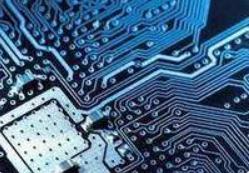PCBs are usually classified according to frequency, number of layers and substrates used. Some popular types are discussed below.
Single-sided PCB is the basic type of circuit board, which only contains one layer of substrate or basic material. This layer is covered with a thin layer of metal, namely copper, which is a good electrical conductor. These PCBs also contain a protective solder mask that is applied on top of the copper layer along with the silk screen coating. Some of the advantages provided by single-sided PCBs are: single-sided PCBs are used for mass production and have low cost. These PCBs are used for simple circuits such as power sensors, relays, sensors and electronic toys.
2. Double-sided PCB
The double-sided PCB has metal conductive layers on both sides. Holes on the circuit board allow metal parts to be connected from one side to the other. These PCBs are connected to the circuit on either side through any of two mounting solutions, through-hole technology and surface-mount technology. Through-hole technology involves passing the lead assembly through a pre-drilled hole on the circuit board and then soldering it to the pad on the opposite side. Surface mount technology involves placing electrical components directly on the surface of a circuit board. The advantage provided by double-sided PCBs is that surface mounting allows more circuits to be connected to the board compared to through-hole mounting. These PCBs are widely used in mobile phone systems, power monitoring, test equipment, amplifiers and many other applications.
3. Multilayer PCB

Multi-layer PCBs are printed circuit boards that include more than two copper layers, such as 4L, 6L, 8L, etc. These PCBs extend the technology used in double-sided PCBs. The layers of the substrate and the insulating material separate the layers in the multilayer PCB. The PCB size is compact, and it has advantages in weight and space. Some of the advantages provided by multi-layer PCBs are: Multi-layer PCBs provide a high degree of design flexibility. These PCBs play an important role in high-speed circuits. They provide more space for conductor patterns and power supplies.
4. Rigid PCB
Rigid PCBs refer to those types of PCBs whose base material is made of solid materials and cannot be bent. They offer some significant advantages: these PCBs are compact, which ensures the creation of various complex circuits around them. Rigid PCBs are easy to repair and maintain because all components are clearly marked. Moreover, the signal path is well organized.
5. Flexible PCB
The flexible PCB is built on a flexible base material. These PCBs have single-sided, double-sided and multi-layer formats. This helps reduce the complexity within the equipment components. Some of the advantages that these PCBs provide are: These PCBs help save a lot of space and reduce the weight of the overall circuit board. Flexible PCB helps reduce the size of the circuit board, so it is very suitable for various applications that require high signal trace density. These PCBs are designed for working conditions, where temperature and density are the main considerations.
6. Rigid-flexible-PCB
Rigid flexible-PCB is a combination of rigid and flexible circuit boards. They include multilayer flexible circuits connected to more than one rigid board. These PCBs are precision constructed. Therefore, it is used in various medical and military applications. These PCBs are light in weight and can save 60% of weight and space.
7. High frequency PCB
The high frequency PCB is used in the frequency range of 500MHz-2GHz. These PCBs can be used in various critical frequency applications, such as communication systems, microwave PCBs, microstrip PCBs, etc.
These aluminum plates are used for high-power applications because the aluminum structure helps to dissipate heat. Aluminum-backed PCBs are known to have high levels of rigidity and low levels of thermal expansion, which makes them well-suited for applications with high mechanical tolerances. PCB is used for LED and power supply.